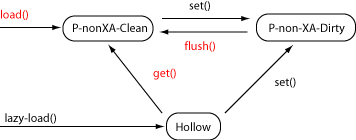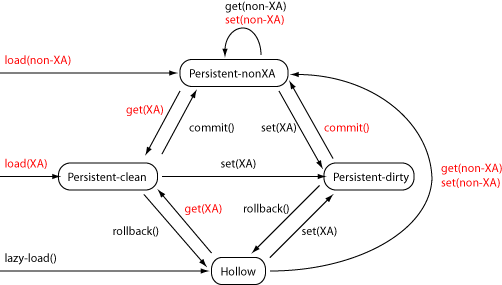
| Amber Lifecycle |
Documentation
Examples
Changes
Overview
Installation
Configuration
Quercus
SOA/IoC
JSP
Servlets and Filters
Admin (JMX)
EJB
Amber
Security
Performance
Hessian
XML and XSLT
Third-party
Troubleshooting/FAQ
Amber
Lifecycle
@Table
| Amber | @Table |
The Amber bean lifecycle follows the JPA model. Amber supports both transactional and non-transactional lifecycles.
Example configuration
The lifecycle description uses a single running example, Test, which
has two properties: getData() which returns a string, and
getParent() which is a pointer to another Test object.
<?xml version="1.0" encoding="UTF-8"?> <entity-mappings xmlns="http://java.sun.com/xml/ns/persistence/orm" xmlns:xsi="http://www.w3.org/2001/XMLSchema-instance" xsi:schemaLocation="http://java.sun.com/xml/ns/persistence/orm orm_1_0.xsd" version="1.0"> <package>qa</package> <entity name="Test" class="qa.Test" access="PROPERTY"> <table name="TEST"/> <attributes> <id name="id"> <column name="ID"/> </id> <basic name="data"> <column name="DATA"/> </basic> <many-to-one name="parent"> <join-column name="FK_PARENT"/> </many-to-one> </attributes> </entity> </entity-mappings>
Non-Transactional Lifecycle
Amber's non-transactional lifecycle has three important states:
- clean: the bean is loaded from the database
- dirty: the bean has unwritten changes
- hollow: the bean is unloaded (lazily-loaded)
In the diagram below, the red methods (load(),
getXXX(), and flush()) query and
update the database.

The aConn.load("1") method loads the bean from the
database and transitions to the state.
Calling test.setData("foo") will change to
the state.
Calling aConn.flush() writes the changes to
the database and changes to the state. Amber may
also flush the changes and change to the clean state
at any time. flush() merely guarantees that the changes
will be flushed to the database.
The state represents lazily-loaded entities. many-to-one
relations and some queries will return the unloaded bean instead of
a loaded bean. When the application calls a getXXX() method,
the bean will load from the database and change to the state.
When the application calls a setXXX() method, the bean
will change to the state.
// load() queries the database and puts test in the clean state
qa.Test test = aConn.load(qa.Test.class, "1");
// getter calls remain in the clean state
System.out.println(test.getData());
// setters change to the dirty state
test.setData("foo");
// parent is lazily-loaded in the hollow state.
qa.Test parent = test.getParent();
// the getter loads parent from the database and changes to the clean state
System.out.println(parent.getData());
// the flush updates test and changes back to the clean state
aConn.flush();
// closing the connection changes all beans to the transient state
aConn.close();
Transactional Lifecycle
In a transaction, Amber loads the bean from the database, even if it was loaded outside of the transaction. (Exceptions exist for cases like read-only beans.) By loading the bean in the transaction, Amber lets the database handle the transactional locking and state consistency.
Just like the non-transactional and states, Amber has transactional and states called and . As in the non-transactional case, the state represents lazily-loaded beans.
- persistent-clean: the bean is loaded from the database within the transaction
- persistent-dirty: the bean has been changed
- hollow: the bean is unloaded (lazily-loaded or rolled-back)
- persistent-nonXA: the bean was loaded outside of the transaction (and would need reloading if used in the transaction)

The main differences from the non-transactional lifecycle are:
- Transactions need a load from inside the transaction. Loads before the transaction cannot be reused.
- Updates occur during the commit() call and change to the nonXA-clean state
- Rollbacks change to the hollow state.
| Amber | @Table |
| Copyright © 1998-2006 Caucho Technology, Inc. All rights reserved. Resin ® is a registered trademark, and Quercustm, Ambertm, and Hessiantm are trademarks of Caucho Technology. |